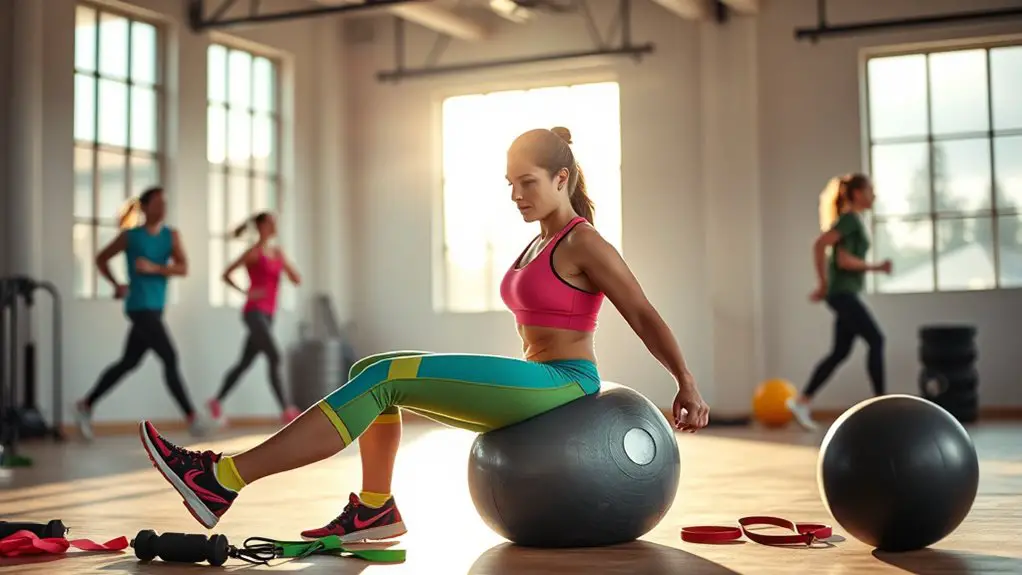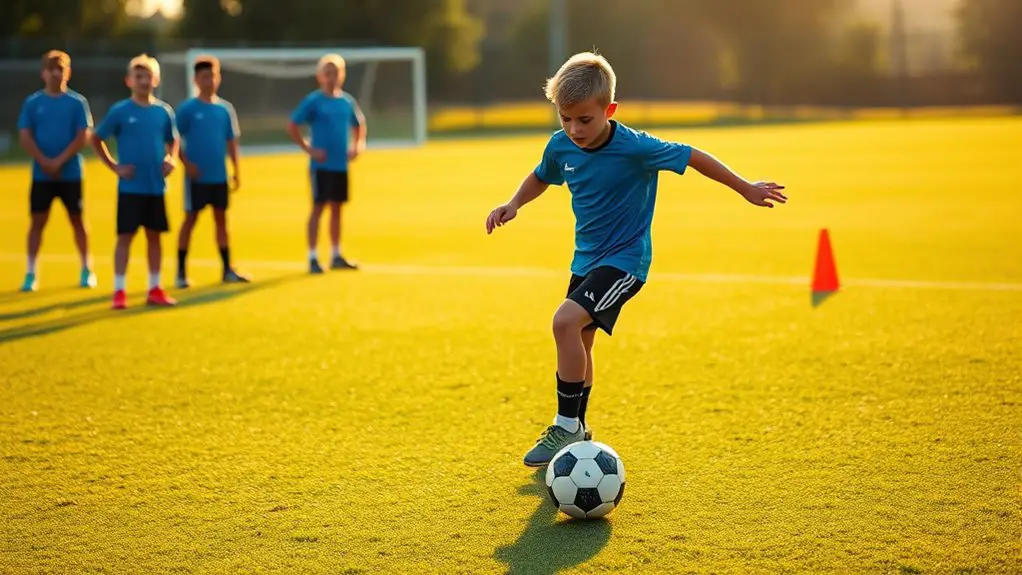For seated athletes, core strength is essential for stability and performance. The best exercises include seated bicycle crunches, Russians twists, leg lifts, and torso rotations. You can also try medicine ball passes and resistance band workouts to enhance engagement. Don't forget seated side bends to strengthen obliques. By incorporating these exercises, you'll improve your core strength effectively. Keep exploring to discover even more techniques and tips that will elevate your training to the next level.
Importance of Core Strength for Seated Athletes
While many may overlook the significance of core strength for seated athletes, it plays an essential role in enhancing performance and stability. A strong core provides the foundation for your movements, allowing you to maintain proper posture and balance while seated. This core stability is critical, especially when you're pushing your limits in your sport, as it helps you control your body more effectively. Without it, you might find yourself struggling with coordination, which can hold you back from achieving your best.
Moreover, investing in core strength is fundamental for injury prevention. A well-conditioned core supports your spine and reduces strain on your muscles, lowering the risk of injuries that could sideline you. By focusing on building your core, you're not just improving your performance; you're also freeing yourself to explore your full potential without the worry of setbacks. Embrace this path to greater stability and freedom in your athletic journey! Additionally, strong core muscles enhance balance and coordination during activities, allowing for more effective execution of complex maneuvers.
Seated Bicycle Crunches
Seated bicycle crunches are an excellent exercise for building core strength, especially for athletes who spend much of their time seated. This move targets your abdominal muscles while allowing you to stay in a comfortable position. To perform it, sit up straight with your feet flat on the ground. Lean back slightly, engage your core, and bring one knee towards your chest while twisting your torso to touch your opposite elbow to that knee. Alternate sides in a controlled manner.
For those new to this exercise or looking for crunch modifications, you can simplify the movement by keeping your feet on the floor or reducing the range of motion. Incorporating seated variations can enhance accessibility, letting you enjoy the freedom of movement while still strengthening your core. So, give seated bicycle crunches a try, and watch your core strength soar!
Seated Russian Twists
Seated Russian twists are a fantastic way to engage your core while remaining comfortably seated. This exercise not only enhances your core stability but also offers various seated twist variations to keep your routine fresh and exciting. Incorporating functional strength training into your workout can help improve overall athletic performance and core engagement.
Here's a quick guide to help you incorporate seated Russian twists into your workouts:
| Seated Twist Variation | Core Stability Benefit |
|---|---|
| Basic Russian Twist | Builds foundational strength |
| Weighted Twist | Increases resistance for growth |
| Slow Twist | Improves control and balance |
| Side-to-Side Twist | Enhances lateral stability |
| Pulse Twist | Engages deeper core muscles |
Seated Leg Lifts
Now let's talk about seated leg lifts, a fantastic way to strengthen your core. You'll learn the proper technique, explore the benefits for your overall stability, and discover modifications to suit your fitness level. This exercise can be a game-changer in your routine, so let's get started!
Technique for Leg Lifts
Leg lifts are a fantastic way to strengthen your core, especially for seated athletes looking to enhance stability and balance. To perform seated leg lifts, sit tall in your chair with your feet flat on the ground. Engage your core, press your back against the chair, and slowly raise one leg, keeping it straight. Hold for a moment, then lower it back down. Experiment with leg lift variations by alternating legs or lifting both at once for added challenge. Focus on using proper lifting techniques; avoid swinging your legs or using momentum. Instead, control each movement to maximize effectiveness. Remember, consistency is key, so incorporate these leg lifts into your routine for improved core strength and stability.
Benefits for Core Strength
Seated leg lifts not only enhance stability but also offer numerous benefits for core strength. By engaging your abdominal muscles during this exercise, you improve core stability, which translates into better overall performance in your seated activities. Strong core muscles support your spine and pelvis, making movements smoother and more efficient. This increased stability helps you maintain balance and control, allowing for greater freedom of movement. Additionally, strong core muscles play a vital role in injury prevention; they reduce the risk of strains and overuse injuries that can arise from weak or imbalanced muscles. Incorporating seated leg lifts into your routine empowers you to build a resilient core, giving you the confidence to pursue your activities without fear of injury.
Modifications for Different Levels
Whether you're a beginner or more experienced, there are modifications for seated leg lifts that can help you tailor the exercise to your fitness level. If you're starting out, focus on beginner modifications like lifting one leg at a time, keeping it low to the ground. This helps you engage your core without overexerting yourself. As you gain strength, try advanced variations by lifting both legs simultaneously or adding ankle weights for extra resistance. You can also incorporate pauses at the top of each lift to enhance control and stability. Remember, it's all about finding what feels right for you while challenging your body. Embrace these modifications, and enjoy the journey to building a stronger core!
Seated Torso Rotations
Seated torso rotations are a fantastic way to enhance your core strength and improve your overall stability. By mastering the proper technique, you can maximize the benefits of this exercise while minimizing the risk of injury. Let's explore how to perform torso rotations effectively and the advantages they bring to your performance.
Benefits of Torso Rotations
While you might think core exercises are only for those who can stand or move freely, seated torso rotations offer significant benefits for athletes in a seated position. These movements enhance your rotational strength, vital for improving performance in various sports. Here's a quick look at the benefits:
| Torso Rotation Benefits | Impact |
|---|---|
| Improved Core Stability | Supports overall posture |
| Enhanced Rotational Strength | Boosts athletic performance |
| Increased Flexibility | Aids in injury prevention |
Proper Technique Overview
Mastering proper technique during seated torso rotations is key to maximizing their benefits. Focus on the following essential points to enhance your core stabilization and maintain posture alignment:
- Sit Tall: Keep your back straight and shoulders relaxed. This position allows for ideal rotation and reduces strain.
- Engage Your Core: Activate your abdominal muscles before you begin. This will help stabilize your torso and protect your spine during the movement.
- Controlled Movement: Rotate your torso slowly and deliberately, using your core to guide the motion. Avoid swaying or using momentum, as this can diminish effectiveness.
Seated Plank Variations
Plank variations can be a game changer for seated athletes looking to build core strength without traditional movements. By incorporating seated modifications, you can achieve stability and strength while enjoying the freedom of movement. Here are some effective variations to try:
| Plank Variation | Focus Area |
|---|---|
| Seated Forearm Plank | Core and shoulders |
| Seated Side Plank | Obliques and balance |
| Seated Reach Plank | Upper body and core |
To perform these seated planks, engage your core, maintain a neutral spine, and hold each position for 20-30 seconds. You'll not only enhance your core strength but also improve your posture and stability. Embrace these variations and discover how they empower your seated workout routine, allowing you to break free from the limitations of traditional exercises. Additionally, incorporating mobility training into your routine can further enhance your overall athletic performance. Your core deserves this dynamic approach!
Medicine Ball Passes
Medicine ball passes are a fantastic way to enhance your core strength and stability while seated. By focusing on proper technique and form, you can maximize the benefits of this exercise. Incorporating mobility training into your routine can further improve your overall performance and adaptability. Let's explore how to execute them effectively to get the most out of your workout.
Benefits of Medicine Ball Passes
While you may think core workouts are limited to traditional exercises, incorporating medicine ball passes can greatly enhance your strength and stability. This dynamic movement taps into the principles of medicine ball dynamics, offering several benefits:
- Improved Core Stability: Engaging multiple muscle groups, medicine ball passes help strengthen your core, making you more stable in various activities.
- Enhanced Power: This exercise trains your muscles to generate explosive strength, which translates into better performance in your sport.
- Versatility: You can easily modify the intensity or incorporate different variations, allowing for a workout that feels liberating and tailored to your needs.
Proper Technique and Form
To maximize the benefits of medicine ball passes, it is crucial to maintain proper technique and form throughout the exercise. Start by sitting tall, ensuring your back is straight and your shoulders are relaxed. This proper alignment keeps your core engaged and prevents injury. As you prepare to pass the ball, focus on your breathing techniques—inhale deeply before you start and exhale as you throw. This rhythm not only enhances your strength but also helps maintain control. When you release the ball, twist your torso slightly to generate power, and always aim for your target with intention. Remember, it's about quality over quantity; a few well-executed passes are far more beneficial than many performed incorrectly. Enjoy the freedom in your movement!
Seated Side Bends
Seated side bends are a fantastic way to strengthen your obliques and improve flexibility in your torso. By incorporating this simple yet effective exercise into your routine, you can achieve greater core stability and enhance your overall performance. Here's how to make the most of your seated side bends:
- Posture: Sit up tall with your back straight and shoulders relaxed. This guarantees you're maximizing the benefits of seated flexibility.
- Bend: Slowly lean to one side, feeling the stretch along your opposite side. Hold briefly, then return to the starting position.
- Repeat: Alternate sides for a balanced workout, aiming for 10-15 reps on each side.
As you engage in this movement, you'll not only build strength but also cultivate a sense of freedom in your body. Incorporating exercises to improve grip strength can further enhance your overall fitness and stability. Embrace the process, and enjoy the journey toward a more flexible and stable core!
Resistance Band Core Workouts
After mastering seated side bends, it's time to enhance your core workout with resistance bands. These versatile tools can help you target your core more effectively, offering resistance band exercises that keep your workouts dynamic and exciting.
Here's a quick overview of some essential resistance band exercises and their benefits:
| Exercise | Target Area | Resistance Band Benefits |
|---|---|---|
| Seated Band Twists | Obliques | Improves rotational strength |
| Seated Band Crunches | Abdominals | Increases core stability |
| Seated Band Rows | Upper Back/Core | Enhances posture and core strength |
| Seated Band Side Bends | Obliques | Increases flexibility and strength |
Incorporating resistance bands into your routine not only aids in building core strength but also provides the freedom to adjust the intensity. This method supports injury prevention by promoting proper movement patterns. Embrace these exercises and feel the difference!
Tips for Maintaining Core Engagement
While engaging your core during workouts is essential, it can be challenging to maintain that focus over time. To help you stay connected and achieve sustained posture, consider these core engagement techniques:
- Breathe Deeply: Focus on diaphragmatic breathing, inhaling deeply and exhaling fully. This not only helps with relaxation but also activates your core.
- Visual Cues: Use mirrors or video to observe your posture. Visual feedback can reinforce your awareness and remind you to engage your core.
- Regular Mindfulness Checks: Set a timer or use reminders to pause and assess your core engagement throughout your workout. This keeps your focus sharp and your posture aligned.
Frequently Asked Questions
How Often Should Seated Athletes Perform Core Exercises?
When it comes to how often you should perform core exercises, frequency recommendations suggest aiming for 2 to 3 times a week. This helps maintain workout consistency, allowing your core to strengthen without feeling overwhelmed. By incorporating these exercises into your routine, you'll not only enhance your fitness but also enjoy the freedom to move better in everyday life. Remember, it's all about finding what works best for you and sticking with it!
Can Core Exercises Improve Athletic Performance for Seated Athletes?
Absolutely, core exercises can greatly enhance your athletic performance. By focusing on core stability, you'll improve balance and control, which are essential for any athlete. Strong core muscles also aid in injury prevention, helping you stay active and free from setbacks. When you invest time in strengthening your core, you're setting yourself up for better overall performance, allowing you to push your limits and enjoy your athletic pursuits even more.
Are There Specific Diets That Enhance Core Strength?
Yes, there are specific diets that can enhance core strength. You'll want to focus on quality protein sources like lean meats, legumes, and nuts, which help build and repair muscles. Don't underestimate hydration's importance, either; staying well-hydrated supports overall performance and recovery. Balance your meals with healthy fats and complex carbs to fuel your workouts. Embracing this freedom in your dietary choices can lead to better core strength and athletic performance.
What Common Mistakes Should Be Avoided During Seated Core Workouts?
When you're doing seated core workouts, it's essential to avoid common mistakes that can hinder your progress. First, make sure your form alignment is spot on; poor posture can lead to strain. Don't forget about your breathing techniques—holding your breath might seem natural, but it can limit your performance. Stay mindful of your body, and remember that freedom in movement comes from proper technique and awareness. Enjoy the journey to a stronger core!
How Do I Track Progress in My Core Strength?
Tracking your core strength is like mapping your journey to freedom; you need clear markers along the way. Start by using progress metrics such as the number of repetitions or duration you can hold exercises. Regular strength assessments every few weeks will help you gauge how far you've come. Don't forget to note how your daily activities feel; that's a great indicator of your growing strength and newfound freedom in movement!




